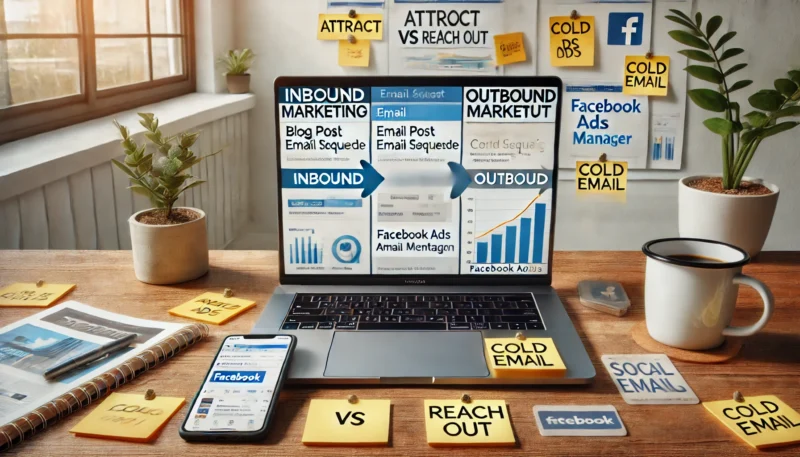When building your marketing strategy, one of the most important decisions you’ll make is whether to focus on inbound or outbound marketing — or both.
These two approaches represent opposite ends of the marketing spectrum: one is about attracting leads naturally, the other is about reaching out directly.
In this article, we’ll explore the key differences between inbound and outbound marketing, their pros and cons, and when to use each approach to get the best results.
What Is Inbound Marketing?
Inbound marketing is a strategy focused on attracting potential customers by creating valuable content and experiences that align with their interests.
The goal is to pull people in by helping them, educating them, or entertaining them — not interrupting them.
Examples of Inbound Marketing:
-
Blog posts and SEO
-
YouTube videos
-
Free eBooks or guides
-
Social media content
-
Email newsletters
-
Webinars or podcasts
Inbound marketing is permission-based — people choose to engage with your content.
What Is Outbound Marketing?
Outbound marketing is about pushing your message out to a wide audience — often through paid or direct channels — with the goal of getting attention and prompting action.
It’s more traditional and often seen as “interruptive,” but it can still be very effective when done right.
Examples of Outbound Marketing:
-
Cold emails or DMs
-
Display and banner ads
-
Facebook and Google Ads
-
Cold calling
-
TV, radio, or print ads
-
Sponsored social content
Outbound is advertiser-driven — you’re initiating the contact.
Inbound vs Outbound: Key Differences
| Feature | Inbound Marketing | Outbound Marketing |
|---|---|---|
| Approach | Attracts leads organically | Reaches out directly |
| User permission | Opt-in (user chooses to engage) | Push-based (initiated by marketer) |
| Channels | Blogs, SEO, social, email, video | Ads, cold emails, phone, sponsorships |
| Timeline | Long-term, compounding results | Short-term, faster reach |
| Cost | Lower ongoing cost, more time investment | Higher upfront cost, faster feedback |
| Relationship | Trust-building and educational | Promotional and transactional |
When to Use Inbound Marketing
✅ Ideal for:
-
Building long-term brand authority
-
Educating your audience
-
Attracting high-intent leads
-
Organic traffic growth
-
Content-driven businesses
Inbound works best when your audience is:
-
Actively searching for solutions
-
Willing to consume content
-
Comparing options before buying
When to Use Outbound Marketing
✅ Ideal for:
-
Quick lead generation or product launches
-
New brands seeking exposure
-
Retargeting website visitors
-
Niche outreach (cold email, LinkedIn messages)
-
Scaling proven offers with paid ads
Outbound works best when:
-
You have a time-sensitive offer
-
You know exactly who you want to reach
-
You need volume and speed
Combining Inbound and Outbound: A Smart Strategy
The best digital marketing plans in 2025 combine both approaches.
Example:
-
Inbound: Blog post ranks on Google → visitor downloads a free guide
-
Outbound: That lead is added to a Facebook retargeting campaign with a time-limited offer
-
Inbound again: They receive a nurturing email sequence with tips and value
This creates a loop of awareness, engagement, and conversion — guided by both permission-based and proactive outreach.
Pros and Cons
Inbound Marketing
Pros:
-
Builds trust and authority
-
Lower cost per lead over time
-
Improves SEO and organic visibility
-
Higher engagement and opt-in rates
Cons:
-
Takes time to see results
-
Requires consistent content creation
-
Harder to control reach and volume
Outbound Marketing
Pros:
-
Fast visibility and results
-
Scalable with budget
-
Easy to test messages and offers
-
Great for launching or promoting
Cons:
-
Can feel intrusive if done poorly
-
Higher cost per lead
-
Ad fatigue and banner blindness risks
-
May generate lower-quality leads
Final Thoughts: Pick the Right Tool for the Right Stage
Inbound and outbound marketing aren’t enemies — they’re tools.
Inbound is like planting seeds: slow to grow, but long-lasting.
Outbound is like turning on a faucet: immediate flow, but stops when you turn it off.
Use inbound to build trust and authority. Use outbound to reach the right people quickly. Together, they give you the best of both worlds.

